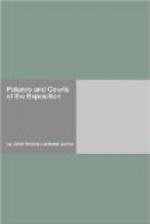The Court is an historical expression of the successive Ages of the World’s growth. The Central Fountain symbolizes the nebulous world with its innate human passions. Out of a chaotic condition came Water (the Basin) and Land (the Fountain) and Light (the Sun supported by Helios, and the Electroliers). The Braziers and Cauldrons symbolize Fire. The floor of the Court is covered with verdure, trees, flowers and fruits. The two Sentinel Columns to the right and left of the Tower symbolize Earth and Air. The eight paintings in the four corners of the Ambulatory symbolize the elements of Earth, Air, Fire and Water. The Central Figure in the North Avenue symbolizes “Modern Time Listening to the Story of the Ages.”
The decorative motifs employed on the surrounding Arcade are sea plant life and its animal evolution. The conventionalized backbone, the symbol for the vertebrates, is seen between the arches. The piers, arches, reeds and columns bear legendary decorative motifs of the transitional plant to animal life in the forms of tortoise and other shell motifs — kelp and its analogy to prehistoric lobster, skate, crab and sea urchin. The water-bubble motif is carried through all vertical members which symbolize the Crustacean Period, which is the second stratum of the Court.
The third stratum, the Prehistoric Figures, surmounting the piers of the Arcade, also the first group over the Tower Entrance, show earliest forms of human, animal, reptile and bird life, symbolizing the Stone Age.
The fourth stratum, the second group in the Altar Tower, symbolizes human struggle for emancipation from ignorance and superstition in which Religion and War are dominating factors. The kneeling figures on the side Altar are similarly expressive. The torches above these Mediaeval Groups symbolize the Dawn of Understanding. The Chanticleers on the finials surrounding the Court symbolize the Christian Era. The topmost figure of the Altar symbolizes Intelligence, “Peace on Earth, Good Will Towards All” — the symbols of Learning and Industry at her feet. The topmost figure surmounting the side Altar symbolizes Thought.
The Arched Opening forming the inclosure of the Altar contains alternating Masks expressing Intelligence and Ignorance in equal measure, symbolizing the Peoples of the World.
A gradual development to the higher forms of Plant Life is expressed upward in the Altar Tower, the conventionalized Lily Petal being the highest form.
L. C. Mullgardt.
Court of the Four Seasons
It will be noticed that this court is planted mainly with grey-green foliage, the banner poles being of the same color.
Flora
Olive trees.
Choisya ternata.
High-grade acacias.
Coprosma (from Chili — a shiny-leafed shrub
on north front).
Eucalypti.
Cotoneaster bufolia (border).
English yews in couples of three groups.
Cypresses.
English laurel.




